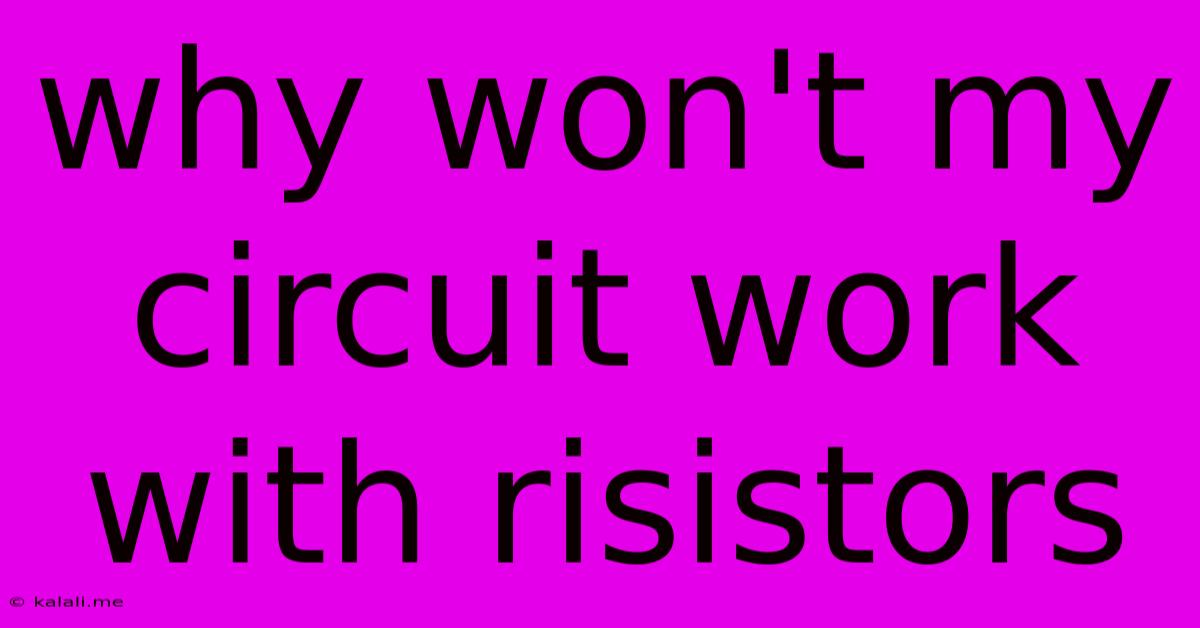Why Won't My Circuit Work With Risistors
Kalali
May 23, 2025 · 3 min read

Table of Contents
Why Won't My Circuit Work with Resistors? Troubleshooting Common Issues
Resistors are fundamental components in almost every electronic circuit, controlling current flow and voltage levels. However, even with seemingly straightforward applications, circuits can fail to function as expected. This article explores common reasons why your circuit might be malfunctioning due to resistor issues, providing troubleshooting tips and solutions. Understanding basic circuit theory and proper resistor selection is crucial for successful electronics projects.
Common Problems and Their Causes:
Incorrect resistor values are a frequent culprit. A resistor with the wrong value can lead to insufficient current, causing components to underperform or fail to function completely. Conversely, a resistor with too low a value can allow excessive current, potentially damaging components through overheating.
Let's break down the most common scenarios:
1. Incorrect Resistor Value:
- Symptom: The circuit doesn't work as intended, components are dim (LEDs), or motors are weak. You might also observe excessive heat from components.
- Cause: Using the wrong resistor value is the most prevalent problem. Double-check your circuit schematic and calculations. Remember to consider tolerance – a 5% tolerance resistor might have an actual resistance 5% higher or lower than its marked value.
- Solution: Verify your calculations using Ohm's Law (V=IR) and other relevant formulas. Use a multimeter to measure the actual resistance of the installed resistors. Replace any incorrectly valued resistors with those of the correct value and tolerance.
2. Open Circuit or Short Circuit:
- Symptom: No functionality, multimeter shows infinite (open) or zero (short) resistance.
- Cause: A broken resistor (open circuit) or a resistor that has physically shorted out (short circuit) can completely disrupt circuit operation. This can be caused by excessive current, physical damage, or manufacturing defects.
- Solution: Visually inspect each resistor for physical damage, such as cracks or burned components. Use a multimeter in resistance mode to check the continuity of each resistor. Replace any faulty resistors.
3. Incorrect Resistor Power Rating:
- Symptom: Resistors get extremely hot, potentially burning or causing damage to nearby components. The resistor may even smell burnt.
- Cause: Using a resistor with a power rating too low for the current flowing through it will lead to overheating. The power dissipated by a resistor is calculated using P = I²R or P = V²/R.
- Solution: Calculate the power dissipated by each resistor. Choose resistors with a power rating significantly higher (at least double) than the calculated power dissipation to ensure safe operation. For instance, if your calculations show a resistor dissipating 0.5W, opt for a 1W resistor or higher.
4. Incorrectly Connected Resistors:
- Symptom: Circuit malfunction despite seemingly correct resistor values.
- Cause: A simple wiring error can render even the correctly valued resistors ineffective. Double-check the connections to ensure they're placed correctly in the circuit.
- Solution: Carefully review the schematic and ensure that each resistor is connected to the correct points in the circuit. Check for loose connections, cold solder joints, or any misplaced wires.
5. Tolerance and Precision:
- Symptom: Circuit performance slightly off from expected values.
- Cause: Resistors have tolerance (e.g., 1%, 5%, 10%). This means the actual resistance could vary within a certain range. For sensitive circuits, this tolerance can cause noticeable deviations in performance.
- Solution: Use higher-precision resistors (lower tolerance) if precise values are critical. Consider the cumulative effect of tolerance across multiple resistors.
Troubleshooting Steps:
- Review the schematic: Double-check your circuit design for any errors.
- Measure resistor values: Use a multimeter to verify the resistance of each resistor.
- Check for shorts and opens: Use a multimeter to check continuity and identify any broken or shorted components.
- Inspect for physical damage: Visually examine resistors and surrounding components for signs of overheating or damage.
- Recalculate power dissipation: Ensure resistors have an appropriate power rating.
- Verify connections: Carefully check all wiring for errors.
By systematically following these troubleshooting steps, you can pinpoint the cause of your circuit malfunction and effectively resolve resistor-related issues. Remember to always prioritize safety and handle components with care.
Latest Posts
Latest Posts
-
Nano Go To End Of File
May 23, 2025
-
Gui From Root Command Line Linux
May 23, 2025
-
It Was A Pleasure To Meet You
May 23, 2025
-
Tar Removing Leading From Member Names
May 23, 2025
-
Fire Magento 2 Validation When Input Changes
May 23, 2025
Related Post
Thank you for visiting our website which covers about Why Won't My Circuit Work With Risistors . We hope the information provided has been useful to you. Feel free to contact us if you have any questions or need further assistance. See you next time and don't miss to bookmark.